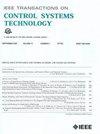通过自适应交互式MPC自动变道:人在环实验
IF 4.9
2区 计算机科学
Q1 AUTOMATION & CONTROL SYSTEMS
引用次数: 0
摘要
本文提出了一种新的基于最优控制的自动驾驶车辆与人类驾驶车辆交互运动规划算法。自我车辆解决了一个涉及两车成本和耦合约束的运动规划联合优化问题,并应用了自己的行动。通过引入整数决策变量处理非凸可行域和车道约束,得到的优化问题是一个混合整数二次规划(MIQP),并通过模型预测控制(MPC)实现。在此基础上,自我车辆采用基于KKT条件的逆最优控制方法估算人类驾驶的邻车成本,并对联合优化成本进行相应调整。我们称该算法为自适应交互式混合整数MPC (aiMPC)。它与驾驶NV的人类受试者在强制变道(MLC)场景中的互动在开发的软件-人在环模拟器中进行了测试。结果表明,与基线方法相比,所提出的算法在增强两种车辆的移动性方面是有效的。本文章由计算机程序翻译,如有差异,请以英文原文为准。
Automated Lane Change via Adaptive Interactive MPC: Human-in-the-Loop Experiments
This article presents a new optimal control-based interactive motion planning algorithm for an autonomous vehicle interacting with a human-driven vehicle. The ego vehicle solves a joint optimization problem for its motion planning involving costs and coupled constraints of both vehicles and applies its own actions. The nonconvex feasible region and lane discipline are handled by introducing integer decision variables and the resulting optimization problem is a mixed-integer quadratic program (MIQP) which is implemented via model predictive control (MPC). Furthermore, the ego vehicle imputes the cost of human-driven neighboring vehicle (NV) using an inverse optimal control method based on Karush-Kuhn–Tucker (KKT) conditions and adapts the joint optimization cost accordingly. We call the algorithm adaptive interactive mixed-integer MPC (aiMPC). Its interaction with human subjects driving the NV in a mandatory lane change (MLC) scenario is tested in a developed software-and-human-in-the-loop simulator. Results show the effectiveness of the presented algorithm in terms of enhanced mobility of both vehicles compared to baseline methods.
求助全文
通过发布文献求助,成功后即可免费获取论文全文。
去求助
来源期刊

IEEE Transactions on Control Systems Technology
工程技术-工程:电子与电气
CiteScore
10.70
自引率
2.10%
发文量
218
审稿时长
6.7 months
期刊介绍:
The IEEE Transactions on Control Systems Technology publishes high quality technical papers on technological advances in control engineering. The word technology is from the Greek technologia. The modern meaning is a scientific method to achieve a practical purpose. Control Systems Technology includes all aspects of control engineering needed to implement practical control systems, from analysis and design, through simulation and hardware. A primary purpose of the IEEE Transactions on Control Systems Technology is to have an archival publication which will bridge the gap between theory and practice. Papers are published in the IEEE Transactions on Control System Technology which disclose significant new knowledge, exploratory developments, or practical applications in all aspects of technology needed to implement control systems, from analysis and design through simulation, and hardware.
 求助内容:
求助内容: 应助结果提醒方式:
应助结果提醒方式:


